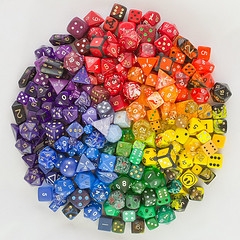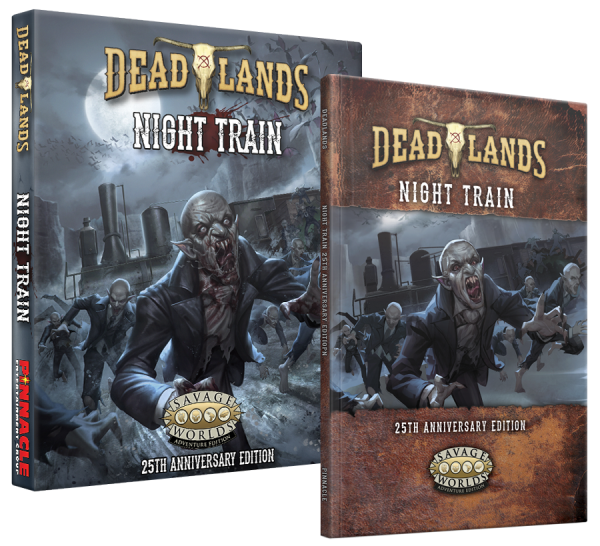Reading Dice
By The Warden
 To everyone who uses playing cards, poker chips, tarot decks, Jenga, or chugs beer to determine the success of your actions, this week’s edition of Under the Hood is not for you. Today, we’re talkin’ dice.
To everyone who uses playing cards, poker chips, tarot decks, Jenga, or chugs beer to determine the success of your actions, this week’s edition of Under the Hood is not for you. Today, we’re talkin’ dice.
I LOVE THESE LITTLE GUYS!! It’s safe to assume we all do, even those who talk about their dice being cursed or having nothing but bad luck rolling them. I know a player who literally groans whenever he’s told to make a dice roll, yet he’s also the first one to respond to the next game’s email shout-out. Despite the mismatch of enthusiasm and output, he’s there nearly every single game with the biggest grin on his face. Me? Well, like I said, I love the little guys. I’d prefer a dice pool game over a single roll game any day of the week because I just love the sound of little clickity-clacks across a wooden table. There’s a reason why many dice rolling apps provide a sound effect option, you know.
Rolling dice and counting up the results is all fine and dandy, but there are ways to use the dice to tell you more than just your success or failure. It’s a practice I like to call “reading the dice” and it’s something we do unconsciously as Gamemasters and players. How you exactly read the dice depends on how the resolution mechanic affects your particular game and it can have a massive impact on your game’s presentation and interpretation of the rules.
For example, let’s say your game requires the standard attack roll against a target number. To make it specific, let’s say you have to a roll a d20, add your attack modifier, and aim for a target number of 17. If your total attack equals 16, the GM describes it as a close call, but no cigar. “The bullet swooshes past the target’s head and smashes into the brick wall behind him.” Or you roll far lower than required, like a 5. “Oh, that doesn’t even come close. The target doesn’t even know that you’re shooting at him and continues to open fire on the civilians cowering inside.” Roll a natural 1? The GM may describe your weapon jamming. Roll a natural 20? The most awesome possible shot becomes the highlight of the evening as the bullet graces through the fast-paced action building up between you and your target, narrowly grazing the armpit of another enemy, tearing through a clothesline, and striking your target square in the temple.
These are all examples of reading dice during play and it can get incredibly detailed when you start to apply other factors in the game’s design. Going back to the above resolution mechanic, let’s assume this game has an Armour rating for opponents to absorb damage. The attack roll is 18, enough to cause damage and roll another die (let’s go with a d8) to simulate your weapon’s impact on their soft flesh. If you roll low damage, the GM describes a perfect shot directly in the centre of the target’s chest, but that area happens to be the best fortified area on the target’s armour. The attack simply causes them to reel in temporary pain before quickly shoving it off and carrying on with their next attack, your strike leaving only a swelling bruise under that folded metal of protection.
A SUBCONSCIOUS EFFORT
On the surface, experienced players like us may find this practise a bit of a no-brainer and it’s a habit I think we’ve learned to perform on our own. Do you know of many games teaching players how to read the dice and present that information in their descriptions? Not very often. Many games with a “What’s a Roleplaying Game?” section and/or provide prospective new players with tips and suggestions for describing the events to players incorporate mechanics such as success levels to gauge something the dice already provide. So let’s take a look at another example and see how you would interpret the results.
Your character makes an attack roll and it’s a narrow success (you rolled an 18 again versus your target’s defence of 17). Rolling the damage, it’s not enough to overcome the target’s Armour rating and it means your opponent takes no damage despite your attack roll. Do you describe the attack as a complete miss or provide context on how the attack hit its mark while simultaneously failing to break through their Armour and make contact with the fleshy innards beneath? Technically speaking, there’s nothing wrong with either description. You could have the opinion that any physical attack unable to cause damage is not a successful attack – the barbarian’s maul rolls over the opponent’s head and touches nothing but air – because of the attack’s overall result. But I’m going to bet the majority of you will describe the attack hitting its objective and failing to cause damage due to the Armour’s toughness and durability because that’s what the dice tell you.
This practice has come to my conscious attention while introducing D&D to some of the kids at the local library where I tutor part-time. Most of them have issues with math and pulling out answers on the fly, so I wanted to introduce a way for them to practice their math skills without paying attention to the fact that they were using math (ew!) to play a dwarf warrior pounding a goblin raider into mush. While we were playing, one of the kids missed his attack target by 1 point and exclaimed “I just missed him!” This is from a kid who’s only learned to play the game in the past hour and even she knows how to read the dice as a manner of describing the action’s outcome.
THE MANY TECHNIQUES OF DICE READING
There are many ways we can consciously or unconsciously read dice to gain a hint towards our action’s success or failure and most of them can work across the board.
- Using differences in numbers. The scale between what you roll and what you need can determine the level of success or failure, depending on which side of the coin your action falls under. If you roll 6 higher than your target number, the GM can describe your character’s accuracy and deadly precision in the strike, while failing by 12 or more results in an embarrassing display of sheer ineptitude. In some cases, games like Fate will assign descriptive success levels based on the differences between dice results and target numbers.
- Rolling the highest number of a die. If your game has exploding dice or simply uses automatic criticals (rolling a natural 20), these moments are demonstrated as epic outcomes of strength or intelligence in the field. A natural 20 on your attack roll is enough to seriously wound the dragon, your hero’s sheer force of will overpowers the tensile strength of the dragon’s scales and causes the beast to cry out in a shriek of pain.
- Comparing dice sizes. Games where effect or success rates are determined by the size of the dice in play (such as effect dice from Cortex+). Stunning an opponent with a sonic ray for only a d4 effect is downplayed as a minor inconvenience, while the same ray inflicted a d12 effect will likely knock the person out cold.
- Multiple versus single dice. If one weapon causes 1d12 damage and another causes 2d6, which would you prefer? Statistically speaking, the only advantage is a smoother average curve on the 2d6 and a pair of six-siders can only go as low as 2 while the d12 can still make it as low as 1. Yet I choose 2d6 every single time. Another example involves bonus damage in the form of bonus dice, such as those gained from critical hits, sneak attack, or other features limited through resource management. These are expressions of the character’s ability to cause more damage than anyone else in a given situation, despite the fact that it’s not a guarantee of massive damage.
Then there are combinations tailored to suit the individual game at play. For one of my own creations, the Optional System, there are numerous dice in play capable of telling many possibilities and I’ve learned some tricks for reading them like tarot cards. By incorporating different dice through different sources, including weapons, into a single action roll, I can pick and choose any particular source’s dice to inspire the description of the outcome. For example, if a character’s assault rifle d10s explode, the player can describe firing a second shot to inflict additional harm on the target, or play up on the a modifier’s dice rolling low by describing the rock used for cover breaking apart until the hail of gunfire.
Reading the dice provides everyone at the table with a source of inspiration and guidance in their descriptions and that’s what I love about this technique. As a former improv contestant, gaining inspiration from tiny clues and hints gets my cranial juices flowing and it’s the perfect tool for GM and players alike as they bring the story to their RPGs.

